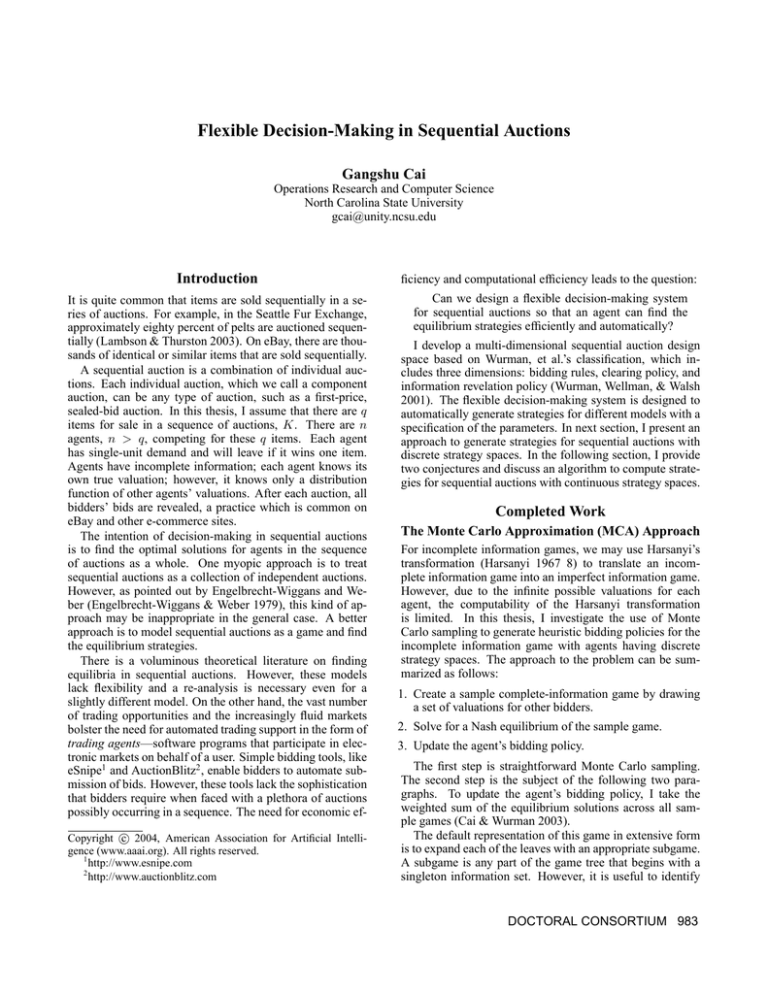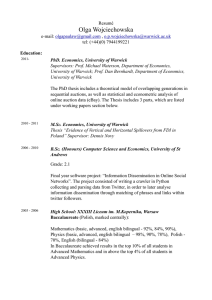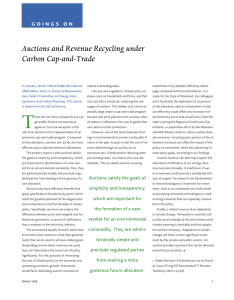
Flexible Decision-Making in Sequential Auctions
Gangshu Cai
Operations Research and Computer Science
North Carolina State University
gcai@unity.ncsu.edu
Introduction
ficiency and computational efficiency leads to the question:
It is quite common that items are sold sequentially in a series of auctions. For example, in the Seattle Fur Exchange,
approximately eighty percent of pelts are auctioned sequentially (Lambson & Thurston 2003). On eBay, there are thousands of identical or similar items that are sold sequentially.
A sequential auction is a combination of individual auctions. Each individual auction, which we call a component
auction, can be any type of auction, such as a first-price,
sealed-bid auction. In this thesis, I assume that there are q
items for sale in a sequence of auctions, K. There are n
agents, n > q, competing for these q items. Each agent
has single-unit demand and will leave if it wins one item.
Agents have incomplete information; each agent knows its
own true valuation; however, it knows only a distribution
function of other agents’ valuations. After each auction, all
bidders’ bids are revealed, a practice which is common on
eBay and other e-commerce sites.
The intention of decision-making in sequential auctions
is to find the optimal solutions for agents in the sequence
of auctions as a whole. One myopic approach is to treat
sequential auctions as a collection of independent auctions.
However, as pointed out by Engelbrecht-Wiggans and Weber (Engelbrecht-Wiggans & Weber 1979), this kind of approach may be inappropriate in the general case. A better
approach is to model sequential auctions as a game and find
the equilibrium strategies.
There is a voluminous theoretical literature on finding
equilibria in sequential auctions. However, these models
lack flexibility and a re-analysis is necessary even for a
slightly different model. On the other hand, the vast number
of trading opportunities and the increasingly fluid markets
bolster the need for automated trading support in the form of
trading agents—software programs that participate in electronic markets on behalf of a user. Simple bidding tools, like
eSnipe1 and AuctionBlitz2 , enable bidders to automate submission of bids. However, these tools lack the sophistication
that bidders require when faced with a plethora of auctions
possibly occurring in a sequence. The need for economic ef-
Can we design a flexible decision-making system
for sequential auctions so that an agent can find the
equilibrium strategies efficiently and automatically?
c 2004, American Association for Artificial IntelliCopyright gence (www.aaai.org). All rights reserved.
1
http://www.esnipe.com
2
http://www.auctionblitz.com
I develop a multi-dimensional sequential auction design
space based on Wurman, et al.’s classification, which includes three dimensions: bidding rules, clearing policy, and
information revelation policy (Wurman, Wellman, & Walsh
2001). The flexible decision-making system is designed to
automatically generate strategies for different models with a
specification of the parameters. In next section, I present an
approach to generate strategies for sequential auctions with
discrete strategy spaces. In the following section, I provide
two conjectures and discuss an algorithm to compute strategies for sequential auctions with continuous strategy spaces.
Completed Work
The Monte Carlo Approximation (MCA) Approach
For incomplete information games, we may use Harsanyi’s
transformation (Harsanyi 1967 8) to translate an incomplete information game into an imperfect information game.
However, due to the infinite possible valuations for each
agent, the computability of the Harsanyi transformation
is limited. In this thesis, I investigate the use of Monte
Carlo sampling to generate heuristic bidding policies for the
incomplete information game with agents having discrete
strategy spaces. The approach to the problem can be summarized as follows:
1. Create a sample complete-information game by drawing
a set of valuations for other bidders.
2. Solve for a Nash equilibrium of the sample game.
3. Update the agent’s bidding policy.
The first step is straightforward Monte Carlo sampling.
The second step is the subject of the following two paragraphs. To update the agent’s bidding policy, I take the
weighted sum of the equilibrium solutions across all sample games (Cai & Wurman 2003).
The default representation of this game in extensive form
is to expand each of the leaves with an appropriate subgame.
A subgame is any part of the game tree that begins with a
singleton information set. However, it is useful to identify
DOCTORAL CONSORTIUM 983
the game structure of individual auctions. Given that the
bidders have complete information, all subgames with the
same players remaining have the same solution(s). Thus, a
single-unit, sealed-bid (component) auction with n agents
has at most n unique subgames—one for each possible set
of non-winners. Our agent’s approach is essentially dynamic
programming, and equivalent to standard backward induction with caching. The agent solves all possible smallest
component games, and recursively constructs higher-order
subgames until it solves the root game.
This leveraged structure enables significant computational savings. The component form representation is exponential in the number of agents and the number of bidding choices. However, the total number of nodes in our
leveraged structure required to express the game is exponentially less than in the full expansion (Cai & Wurman
2003). For example, five-agent, four-item sequential singleunit auctions with five bid choices and random tie-breaking
require only 1931 nodes to encode in the component form,
compared to the 4.5 billion required for the naive expansion.
Empirical Results
To evaluate the efficacy of the approach, I simulated several
market configurations in which I varied the bidding rules, the
functional form of the valuation distributions, the form of the
update equation, and the strategies of the other bidders.
In the experiments, I measure the utility for our agent,
the social welfare, and the revenue achieved by the seller.
The performance of the MCA strategy is quite close to that
of the subgame perfect equilibrium both when the other
agents play perfectly and when they construct their own
MCA strategies. This result indicates that the approximation technique generates policies that perform quite well in
this environment (Cai & Wurman 2003).
A perfect Bayesian equilibrium (PBE) is defined in terms
of beliefs at decision points in the game, and requires that
an equilibrium policy be consistent with those beliefs. The
MCA policy at a node implicitly captures the agent’s beliefs
about which opponent valuations would explain the fact that
the agent arrived at a particular decision point in the game
tree. I have shown that MCA strategies converge to the average policy of PBE (Cai 2003).
Proposed Work
I expect to complete three threads of related research. The
first one involves showing the relevance of different MCAs
to PBE. A successful proof of the convergence of MCA
strategies to PBE would validate the significance of using
the MCA approach to compute equilibria in sequential auctions. In a previous report (Cai 2003), I introduce another
policy update function. This function is a weighted update
function in which I add utility to the policy update function
to allow more weight to those bids which yield more utility.
My preliminary analysis lends support to a conjecture:
Conjecture 1. For a class of sequential-auction games, the
weighted MCA strategies converge to PBE.
The second and third threads are related to sequential auctions with continuous strategy spaces. Weber’s model (We-
984
DOCTORAL CONSORTIUM
ber 1983) is a classic sequential auction model with continuous strategy spaces, in which the auctioneer announces only
the winner and its bid. However, solutions change when we
simply change the announcement rule. On the basis of some
preliminary analyses, I conjecture:
Conjecture 2. In a single-unit demand, independent private
value sequential auction model with incomplete information
and a price quote in which the auctioneer announces the
bids of all agents after each auction, there does NOT exist
an equilibrium in pure strategies.
Most literature on sequential auctions is aimed at finding equilibria in pure strategies. The second conjecture suggests that there might be some sequential auction models, in
which pure strategy equilibria do not exist, and moreover,
this is the type of auction prevalent on the Internet.
In the third thread, I plan to design an algorithm to generate strategies for sequential auctions with continuous strategy spaces. One approach is to discretize the continuous
strategy spaces so that we may use the previous MCA approaches to approximate a solution. Another approach could
be a heuristic algorithm by combining best response and
search algorithms under a leveraged structure similar to the
MCA approach for models with discrete strategy spaces.
Conclusion and Contribution
This thesis has the potential to contribute to both computer
science and economics. The computer science contribution
lies chiefly in the development of automatic and efficient
algorithms for solving sequential auction games. The economic contribution is the theoretic analysis of the existence
of equilibrium in sequential auctions and the relevance of
MCAs to PBE for a class of sequential auction models.
References
Cai, G., and Wurman, P. 2003. Monte Carlo approximation in incomplete-information, sequential-auction games.
Decision Support Systems. Forthcoming.
Cai, G. 2003. Flexible decision-making in sequential auctions: A dissertation proposal. North Carolina State University.
Engelbrecht-Wiggans, R., and Weber, R. J. 1979. An example of a multi-object auction game. Management Science 25:1272–1277.
Harsanyi, J. C. 1967-8. Games with incomplete information played by bayesian players. Management Science
14:159–182,320–334,486–502.
Lambson, V. E., and Thurston, N. K. 2003. Sequential auctions: Theory and evidence from the seattle fur exchange.
A working paper.
Weber, R. J. 1983. Multiple-object auctions. In
Engelbrecht-Wiggans, R.; Shubik, M.; and Stark, R. M.,
eds., Auctions, Bidding and Contracting: Uses and Theory. New York University Press. 165–91.
Wurman, P. R.; Wellman, M. P.; and Walsh, W. E. 2001.
A parametization of the auction design space. Games and
Economic Behavior 35:304–338.




